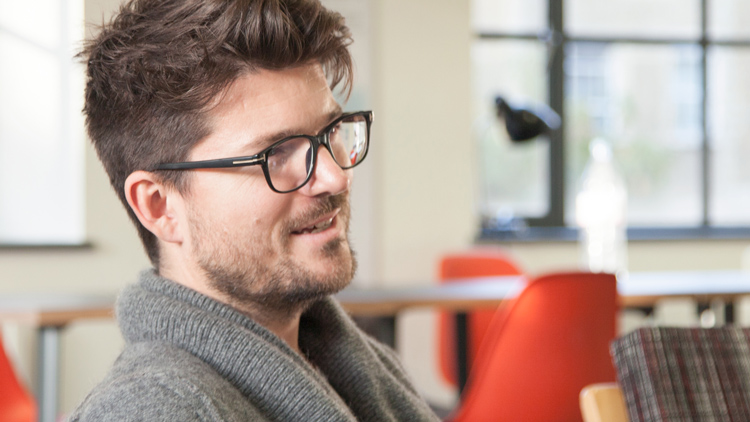“Let’s not be elitist about what we do”: should designers give away their secrets?
Pentagram partner Natasha Jen recently lambasted the term “design thinking” as “bullshit”, “jargon” and “extremely dangerous”. Designers share their thoughts on the concept and discuss whether teaching design skills to businesses is helpful or irresponsible.

“Our industry is notoriously bad at articulating its value to our clients and the wider world. If it takes terms like ‘design thinking’ being appropriated by that wider world as a fashionable buzz-phrase to demonstrate intellectual rigour and value creation, then I’m all for it. We really do have to create an industry standard to demonstrate impact and effectiveness. Frankly, the more mainstream the understood value of our processes becomes, the better. It’s a great opportunity to harness good will. Let’s not be elitist about it!”

“I would like to promote more doing than thinking, and not caring so much for semantics. I have spent the past three years programming and running Design Thinking projects at postgraduate level, and it seems to come down to learning the skills to empathise with who we are designing for, and to collaborate with each other to design valuable things; be it products, services, businesses, interactions, environments, systems, governments, the world. It’s not just about graphic design, which Natasha Jen is referring too. Her thoughts are, in my opinion, quite thin in relation to the broader design industry.
The definition of design is ever-changing due to technology and the increased interaction between users and businesses. It plays a bigger role in the boardroom than ever before, and is on the tip of C-Suite tongues. Whatever you think of the buzzword, bullshit or otherwise, it’s just a tool – if it doesn’t work for you, use a different tool.”

“‘A little knowledge is a dangerous thing’ or ‘imitation is the sincerest form of flattery’? Design is a mindset and a skillset, a mixture of head, heart and hand. Head for skills such as visualisation and conceptualisation, heart to understand and empathise with the person you are designing for and hand for the drawing, coding, computer aided design (CAD) or other methods you use. Design thinking used judiciously, thoughtfully and in experienced hands can open up a range of different ideas and help people create unexpected solutions, moving them from the first statement to the second in a skilful way – so let’s embrace design thinking, but with more care.”

“Educating so that others understand design and what it takes to achieve it can’t be a bad thing! We all use a logical process to tackle design problems, but ultimately it’s just a springboard that we will deviate to and from along the way because every project is different – not forgetting potential creative challenges from the client – and so we adapt the ‘process’ accordingly.
What’s also difficult to define in a process is the ‘what if’. It’s the illogical part of creativity where the magic happens. It’s what you can’t define in a step-by-step guide. Those little gems you discover when digging deep, your gut instinct for what feels right, and the ultimate beauty of its aesthetic. Rarely does this happen in a step-by-step process.
Sometimes it’s the tenacity you need to go back again, or to allow yourself to break free and think differently, that will enable you to create powerful and memorable design that truly connects to the consumer in an emotive and informative way. And surely that’s what we’re all striving to achieve as designers?”

“Design thinking isn’t thinking – that’s the irony. It’s a process; a process that prompts us to put the user first, in other words, take a ‘customer-centric approach’. Using a process to arrive at your solutions is the design equivalent of being a battery farm hen. But aside from this, when oh when was design not about the user anyway?
Don’t get me wrong, design thinking has opened the valve within a lot of businesses to have the design discussion. But it is not an alternative to designers in business, where they are desperately needed. Realising corporate ambition is a very big ask, and only those with the expert intuition, born out of years of design practice, should be meddling in the affairs of corporations at board level.”

“At progressive studios, we help clients solve delightfully complex problems. This complexity can be dangerous if we’re not serious about the opportunity to critically think and talk about the tools we use.
It’s encouraging to see that the Design Indaba stage was used for more than a portfolio show-and-tell and that Natasha was able to voice an important point of view. Personally, I both disagree and agree with her.
I disagree because I believe complex problems benefit from the tools that force us to think about them. I agree because it’s usually the wrong tools that are used to solve the wrong problems.
Great design teams know which tools should be used to solve which problem. Really great design teams know how to invent tools to solve problems in even more interesting ways.”

“There’s a poster that pops up on the London underground every year promoting an art college with the headline ‘Become a graphic designer in three months’. It drives me mad.
I’ve been doing graphic design since 1986 and I still think I’m not a graphic designer (no comment). I truly believe it’s a life job, a wonderful, beautiful, joyous commitment to experimentation, with daily experiences of learning, craft, collaborating and solving problems with words and images. It’s endless.
‘Become a graphic designer in 3 months’ and other miracle short-cuts to the solution – along with the jargon that popularises them – are basically peddling a lie.
I’m a firm believer that intuition and gut feeling are every bit as important as solid design thinking and strategic processes. So here are my buzzwords: Tell the truth, turn up on time, have brilliant ideas, build a trusted relationship and have fun. Amen.”

“Like almost everything in our industry, so much of it seems to rest on semantics. If we take Ideo’s definition – ‘a human-centred approach to innovation that draws from the designer’s toolkit’ – then it’s hard to argue against, surely. But the design thinking Natasha hates – a dumbed-down, rigid five-step process that can be taught for £2.99 – is obviously bullshit. Mainly because it’s not design thinking. No designer I know thinks like that, anyway.”
What are your thoughts on design thinking? Let us know in the comments below.





Design thinking has become an excuse for the failure to practise design. The manual skills of drawing, making and training the eye and hand to observe the aesthetic nuances that communicate are seen as too hard for design practitioners, undervalued as trade skills. Design has been usurped by unskilled marketers. I can think about being a great tennis player until I convince myself and others but until I undertake the physical discipline of training my eye and my body to hit a ball it’s all wishful thinking. Design thinking? Eventually some one has to DO it.
The problem with British design is that it just doesn’t engender any excitement any more. At best, it’s become prettified functionality. And there is a kind of dishonesty about that functionality, too: we pretend it is all about ‘designing for users’ when in fact it is about delivering value to owners, steering the user like a cow in an abattoir towards outcomes which meet ‘business objectives’. The UK design community’s decades-long obsession with commerce has resulted in a kind of design which is dead from the neck down — all rationale, and no passion. It’s disappeared up the C-suite’s arse.
For as long as I have been a practicing graphic designer, the design community has searched in vain for a methodology that would explain the value of graphic design to the people who purchase it, and also obfuscate the fact that it takes talent on the part of the designer to create a reasonable solution to a brief that is understandable, aesthetically satisfying. and memorable. Design thinking is the current method that seeks to create a faux science out of an often seemingly arbitrary process and imbues the client with design talent too!
The client participants engaged in the process are really engaged in more intense brief writing, not graphic design. At the end of the process some poor designer is going to gather all those post-it notes and post rationalize the design so as to include every redundant or irrelevant comment.
Thoughtlessness can never be helpful. Personally, I trust what I feel more than what I think, but that doesn’t blind me to the value of thought or thoughtful design. Einstein was right, as he usually is, when he says: “We cannot solve our problems with the same thinking we used when we created them. So, as with most things, it depends on the quality of thinking and even more on what thinking actually is. Is imagination thinking? If not what is it? Without imagination there can be no design.
4.22. Time for a little something. Is that a thought or a feeling? Does it matter? What does matter is what my imagination produces, and now it’s conjuring up a cup of white tip tea and a brownie. Is that design thinking? To my mind, it is.
Great topic and a constant debate amongst peers! The creative process is usually one of distillation and a removal of as much subjectivity as possible. To distill to the right solution in a commercial environment, we need to ground our thinking in insight. Some clients like to be part of the process and the theatre, expecting and enjoying an element of ‘entertainment’ – with workshops, flip chartsPost-It notes. Others trust our process without much involvement. So why not ask the clients?
Design shouldn’t be just a 9-5 career, it should be an obsession which takes over your life. You can’t stop progress but designers need to mobilise that obsessive energy to take back control of the land – their land – which is being eroded by the ever-tightening chokehold of the internet, its abundance of cheap and cheerful services, hasty training and the ‘we can do it ourselves’ mentality.
As a business, I waste so much energy trying to explain to CEOs and marketeers the substantial commercial value we can bring to their products or services through our twenty years + of obsessing and getting results from great design. But maybe they should understand this intrinsically, through education via professional qualifications or peers before they take on the responsibility of buying creative?
Duncan, I’ve got my pitchfork ready, give me a time, give me a place and I’ll see you there old bean.
Designers do look at the world a little differently. And not explaining ‘design thinking’ to others in a rational way is naive. Not everyone gets it, sees the value or cares. I think it’s great that the conversation has moved on from the self serving ‘passionate’ design community.
I’m quoting Sarah Dawood (above) “Designers share their thoughts on the concept and discuss whether teaching design skills to businesses is helpful or irresponsible”… perhaps the problem is in wanting to teach design skills to businesses.
If we are able to teach people how to use skills like empathy and rapid idea generating and iteration are we doing designers a disservice? Seems to me it’s all in the approach and the implementation. If you are to assume people cannot be trusted with information, then sure, let’s keep it to ourselves. But wouldn’t it be nice to share knowledge so that people can be informed? There’s a reason we go to K-12 to learn a little about a lot of subjects. We get a taste of what’s available and then we specialize.
How about making the basic concepts of design thinking available and accessible to everyone, which would raise both awareness and empathy for the process. Remove design from its pedestal (and plenty of people bandy about the term ‘design’ ruthlessly already) and then use it with care. Then non-designers can have MORE appreciation for design because they are aware and have a basic education in design.
(Scandinavian countries seem to have no problem integrating design into their culture, is that because design was never removed from the grasp of society? Merely a hypothesis…)
The following is a comment I made on Natasha Jen’s post on ‘Design Thinking’ last month. It is just as relevant for this topic.
For me, the term ‘Design thinking’ is just another of those buzzy phrases like ‘Joined up thinking’ or ‘Collaborative working’, concocted by jargon spinners who like to start their sentences with ‘So’.
I have been in the world of graphic design since the early 1960’s.
I never went to art school, I’m dyslexic and everything I know has been driven out of passion and curiosity. Over the decades I have witnessed many isms come, go and return. I have never particularly wanted to know how I think. I just do it. I don’t believe it can be applied to people like a magic plaster. You either think in a unique way or you don’t. As a keen observer of our industry over many years what is now sadly lacking, in this hugely overpopulated industry, is the fingerprint of the individual. Where are the likes of Paul Rand, Alan Fletcher, Pierre Mendell, Massimo Vignelli, Saul Bass, Willy Fleckhaus and Josef Muller-Brockmann? I could go on and on. The immediacy of the digital age has created work of enormous similarity in almost every creative area, making it difficult to identify the wood from the trees.
You can pull together acres of research and focus group reports etc, but in the end, a designer, either at their desk, in a coffee shop, or waking up in the dead of night, will suddenly have that elusive ‘idea’ that pops up like magic. There is no rhyme or reason. It’s a case of acuminated knowledge and experience of looking and noticing when others just don’t see. It’s a special antenna that some of us are blessed with, and you can’t buy it off the shelf.
As a mature student (33! Harsh term I think, but still) of a Design and Innovation degree, we spent our whole first year on ‘Design Thinking’. I had never heard of the term before I started this degree so was a little taken aback that the process was actually studied, and in such detail. Wrongly or rightly, I had just presumed that you either have this type of thought/ design process or you didn’t.